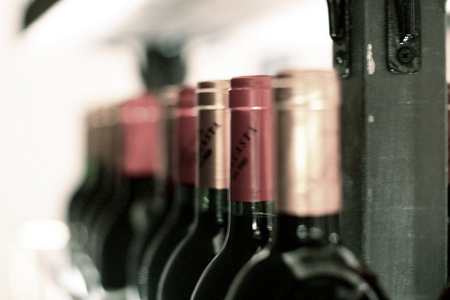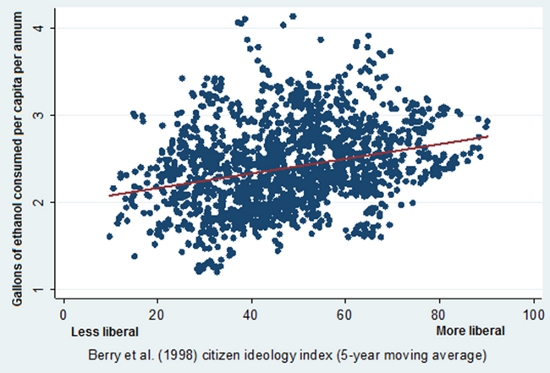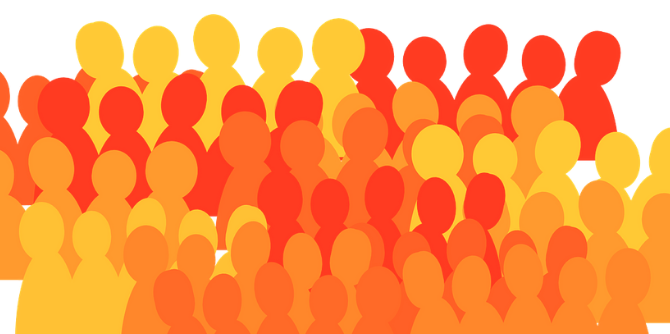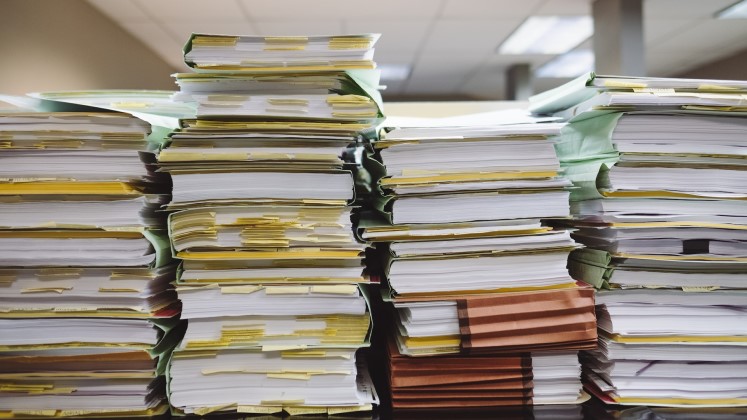
 Across the U.S., levels of alcohol consumption often vary significantly from state to state. In a new study, Pavel Yakovlev and Walter Guessford investigate the relationship between an individual’s political beliefs and consumption of alcohol. Using data on drinking habits in 50 states between 1952 and 2010, they find that people in states that become more liberal over time consume more beer and spirits, but less wine.
Across the U.S., levels of alcohol consumption often vary significantly from state to state. In a new study, Pavel Yakovlev and Walter Guessford investigate the relationship between an individual’s political beliefs and consumption of alcohol. Using data on drinking habits in 50 states between 1952 and 2010, they find that people in states that become more liberal over time consume more beer and spirits, but less wine.
Excessive alcohol consumption imposes significant costs on society in terms of alcohol-related productivity losses, violence, poor health, and motor vehicle collisions. Alcohol consumption and its costs are also not uniformly distributed. For instance, one of the top causes of male mortality is heavy drinking.
While significant progress has been made in uncovering the determinants of alcohol consumption, the effect of consumer preferences on drinking behavior remains somewhat of a black box, perhaps due to the esoteric nature of preferences. Political beliefs or ideology could be one of them. Several studies in political science on the origins of preference formation indicate that political beliefs can capture a wide variety of individual preferences and social attitudes. Recent research in psychology and sociology suggests that there might be a connection between an individual’s political beliefs and unhealthy behaviors such as heavy consumption of alcohol, tobacco, and illegal drugs.

Intrigued by this conjecture, we investigated the relationship between alcohol consumption and political ideology in the United States using a longitudinal panel of 50 states from 1952 to 2010. In our recent study we find that states that become more liberal over time consume more beer and spirits but perhaps less wine (in gallons per capita). We also find that alcohol consumption converted into gallons of ethanol per capita rises in states that become more liberal over time. These results hold even after controlling for economic, demographic, regulatory, religious, and other differences across states. The results do not appear to be driven by outliers. In fact, the observed positive correlation between liberalism and drinking is stronger when the largest consumers of booze and possible outliers like Nevada and New Hampshire are excluded from the analysis (see Figure 1).
Figure 1 – Gallons of Ethanol consumed per Capita and Citizen Ideology (48 States, 1976-2006)

Notes: The citizen ideology index ranges from 0 to 100; higher values indicate more liberal states. Nevada and New Hampshire are excluded as possible outliers.
The positive and statistically significant correlation between alcohol consumption and liberalism depicted in Figure 1 is based on the observations pooled across states and years. Interpreting this “pooled” correlation as proof that “liberals drink more than conservatives” might be erroneous because differences in ideology and drinking patterns across states can be driven by a third factor that is correlated with both of them. In our study, we employed methods to capture all unobserved factors that contribute to differences in alcohol consumption across states and over time.
Perhaps the most intriguing finding in our study is that wine consumption per capita appears to increase (decrease) in states that become more conservative (liberal) over time. However, this correlation becomes insignificant when accounting for some additional factors that influence wine consumption. Also, it is important to note that the estimated alcohol-ideology relationship is rather weak in magnitude: the elasticity estimates for the ideology variable range from 0.02 to 0.13 in absolute value, implying that alcohol demand is not very responsive to changes in ideology. To put these estimates into perspective, consider this prediction from one of our models: if ideology were to increase by one standard deviation (equivalent to Michigan becoming as liberal as Vermont), the average per capita beer consumption could rise by about 2 gallons if nothing else changes. However, the results obtained with an auxiliary panel data estimator yield higher elasticity values.
What made our fixed-effects analysis possible is the existence of time variant state ideology index developed in 1998 by political scientists William Berry, Evan Ringquist, Richard Fording, and Russell Hanson. Their citizen ideology index ranges from 0 to 100 (higher values indicate more liberal states) and is based on the voting patterns of state representatives in Congress. Massachusetts, the most liberal state in the index, has become even more liberal over time and saw a general rise in beer, wine, and spirits consumption per capita. The most conservative states in America, like Mississippi and Virginia, have become more liberal over time as well, but experienced very different trends in alcohol consumption. Virginia saw an overall decline and Mississippi an overall increase in ethanol consumption per capita. Both states, however, saw a general increase in beer and wine consumption and fall in spirits consumption per capita over the last four decades. These examples highlight the basic fact that each state’s experience is unique and may deviate from the average correlation documented in our study.
But there is a bigger and more speculative question lurking behind our estimates: does becoming more liberal make one drink more alcohol? Strictly speaking, the empirical results in their present form cannot ascertain if liberal beliefs cause more drinking. However, there is no shortage of speculations as two why the two might be correlated. We have come across studies suggesting that liberal ideology may represent more tolerant attitudes towards the consumption of alcohol, among other things. Thus, liberal ideology might simply capture some consumer preferences in the demand function. Other studies suggest that people might be inclined to consume more alcohol in the presence of a stronger social safety net or a “nanny state”, akin to another form of moral hazard. We hope that future research will provide the definitive answer.
This article is based on the paper “Alcohol Consumption and Political Ideology: What’s Party Got to Do with It?” in the Journal of Wine Economics.
Please read our comments policy before commenting.
Note: This article gives the views of the authors, and not the position of USApp– American Politics and Policy, nor of the London School of Economics.
Shortened URL for this post: http://bit.ly/1bmK4hU
_________________________________
 Pavel Yakovlev – Duquesne University
Pavel Yakovlev – Duquesne University
Pavel Yakovlev is an Associate Professor of Economics at Duquesne University, where he teaches microeconomics, macroeconomics, and public economics courses. Pavel is a recipient of the WVU Foundation Distinguished Doctoral Fellowship in Social Sciences.
_
 Walter Guessford- Duquesne University
Walter Guessford- Duquesne University
Walter Guessford is a Research Assistant at the Department of Economics at Duquesne University.






